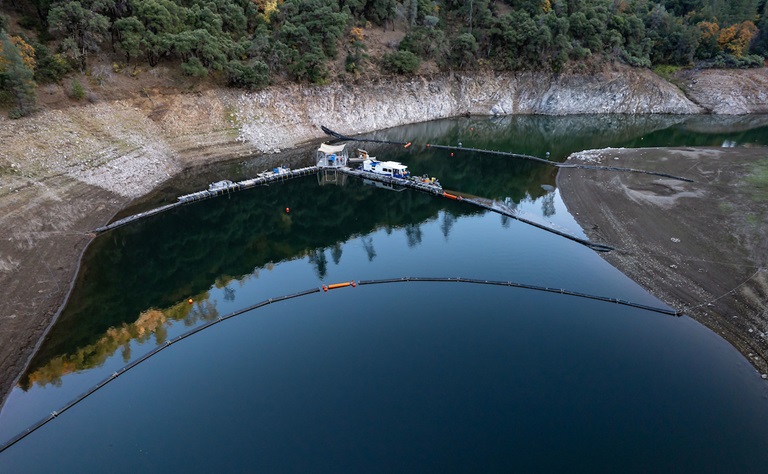Innovative Collection System Supports Reintroducing Winter-run Salmon to the McCloud River
A drone photo shows the California Department of Water Resources’ Juvenile Salmonid Collection System (JSCS) Pilot Project — in partnership with NOAA Fisheries, the California Department of Fish and Wildlife, the Winnemem Wintu Tribe and others — in the upper McCloud Arm of Shasta Lake in Shasta County, California. Photo taken November 8, 2023.
The Department of Water Resources (DWR), along with its Tribal, state, and federal partners, are testing a pilot project that will help with the reintroduction of juvenile winter-run Chinook salmon, an endangered species, to the McCloud River. The reintroduction is important because salmon haven’t been able to access this area since the 1940s when dams were built and blocked all fish migration.
The pilot project involves installing a floating structure that spans the width of the river called the Juvenile Salmon Collection System (collection system) at the point where the McCloud River meets Shasta Reservoir. The collection system is designed to safely catch juvenile winter-run Chinook salmon as they emigrate out of the upper river, before they get stuck in the vast reservoir. What makes the collection system so unique is it's a passive system that can be moved as river and reservoir levels change.
“It doesn’t have any pumps on it to create any velocity. In the northwest, they have these big floating surface collectors that cost $50 million for a system,” said Randy Beckwith, DWR senior engineer, Division of Multibenefit Initiatives. “If our collection system is successful, then it’s a much more cost-effective system that we can use here and other areas of California.”
Two Year Pilot Project
The project launched in 2022. During that first year, no fish were collected, and the focus was testing the collection system to figure out the best depth, location, and methods to collect fish. Then in 2023, the project expanded with the goal of collecting juvenile winter-run Chinook salmon. The project is a collaborative effort between DWR, California Department of Fish and Wildlife (CDFW), National Marine Fisheries Service (NMFS), and the Winnemem Wintu Tribe. The Tribe, CDFW, and NMFS worked together to place salmon eggs into the river using egg incubators with the hope that they would hatch and thrive in their natural habitat.
To test how well the collection system worked, DWR also performed “efficiency releases” once a week. The efficiency releases involved releasing 300 hatchery-raised and tagged juvenile winter-run Chinook salmon once a week upriver from the system, and then seeing how many of those fish were caught in the collection system’s trap. The DWR team have used their knowledge of fish swimming behavior and manipulated the collection system to try to get the best velocity to funnel fish into the collection system’s trap. The efforts have been successful.
“We’re catching dozens of salmon a day most of the time. Sometimes hundreds of salmon a day,” said Theo Claire, DWR environmental scientist, Division of Multibenefit Initiatives.
Comparing sizes: hatchery-raised vs. river-hatched
Once the juvenile salmon are collected, they are checked to see which are hatchery-raised and which are river-hatched. The two types are compared to see how fast and how big the river-hatched fish have grown in comparison to those raised in the hatchery. If the river-hatched juveniles do well, then that is evidence the historical habitat above the dams is good for the salmon. After the juvenile salmon are checked, DWR places the fish into containers. The containers are given to CDFW and Winnemem Wintu Tribal monitors to physically transport and release the fish below the dams on the Sacramento River.
Cultural and Environmental significance of salmon
The pilot project and its goals have cultural significance to the Winnemem Wintu Tribe. Nur is the Winnemem Wintu word for salmon and Winnemem Waywaket is the name of the McCloud River. Since the dams block Nur from accessing their cold water, historical habitat, this project is the beginning of long-term reintroduction of salmon to the Winnemem Waywaket in the McCloud watershed.
The collection system is placed in the McCloud River in Northern California. The McCloud River spans Shasta and Siskiyou counties, and was historically home to four runs of Chinook salmon. The construction of dams like Keswick Dam and Shasta Dam in the 1940s means salmon haven’t been able to access their historic spawning grounds for almost 80 years.
This matters because salmon are what’s called an “ecological keystone species.” Since salmon are born in rivers, migrate to the ocean, and then return to the river to spawn, they bring important nutrients from the ocean to freshwater ecosystems. Those marine nutrients allow the forests surrounding rivers to grow. So, it’s a problem for the environment if salmon are not able to access their spawning site. It’s also a problem for the existence of salmon itself.
Saving Salmon
“There is a growing scientific consensus that if we are going to prevent the extinction of salmon in California, we need to start getting fish above dams,” Claire said.
Currently, spring-run and winter-run Chinook Salmon are listed at the state and federal level as “threatened” and “endangered” respectively, which means they are considered at critical risk of extinction. Meanwhile, fall-run and late-fall-run Chinook Salmon are federally listed as a “Species of Concern,” which is still considered to be at high-moderate risk of extinction. To make sure extinction doesn’t become a reality, DWR scientists say efforts like this pilot project are necessary.
“The reintroduction of winter-run Chinook salmon above a rim dam is a big deal,” Claire said. “All of the project partners are at the early, early stages of figuring out what a full reintroduction project might look like, but we are all really excited about where it could go.”
To see the Juvenile Salmon collection system in action and learn more about the project watch these videos of year 1 and year 2 of the project and view DWR’s photo gallery.
